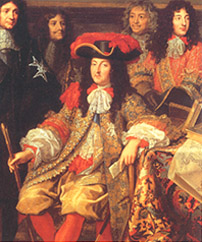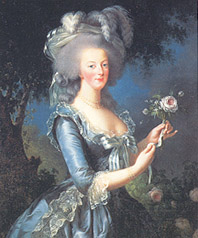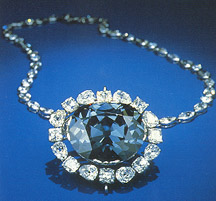

The Leszczynski Family and the French Bourbon Dynasty
***Please be advised that most English text, regarding lineage, differs from author to author. As all good genealogists must do, be sure to check and recheck in various sources. Remember that many records simply do not exist in modern times, thus this should only be used as a guide. Also note that these tables are not complete - this table shows the most notable members only. Thank you.
Written and researched by Margaret Odrowaz-Sypniewska
The Emblem of French Monarchy:
 .....
.....
This is the crest of Charles VI, King of France (1368-1422). Charles was the first king to display only the three fleurs-de-lys (three lilies), which was altered from the first blazon (with many more fleurs-de-lys). This was officially changed sometime around the year 1365, in honor of the Holy Trinity. This pattern was previously seen, as early as 1228, on the seal of the town of Lens.
Many think the change was associated with the reign of
Charles V, The Wise, (1316-1364). Charles V married Joan (1338-1377), daughter of Peter I, Duke of Bourbon. Their son was Charles VI. Charles VI (1364-1380) was a minor surrounded by powerful uncles with large estates. In 1388, when he reached age twenty-one, Charles VI declared himself of age. Charles VI married Isabel (1369-1435), daughter of Stephen III, Duke of Bavaria. Later Charles had a mental collapse. During his madness, his brother, Louis (1371-1407)was the Duke of Orleans (in 1392)and became a rival of the House of Burgundy. Louis, married Valentine, daughter of John Galeazzo, Duke of Milan. Louis was murdered.
Charles VI had heirs to the House of Valois-Orleans and Angouleme. His daughter, Catherine (1401-1438) married (1) Henry V of England (2) Owen Tudor who was executed in 1461. His son, Charles VIII (1403-1461), was King of France in 1422. Charles VIII married Mary of Anjou (1404-1463), daughter of Louis II, Titled the King of Naples.
GENERATION ONE:
John II, Count of Vendome (d.1477) married Isabel, daughter of Louis of Beauveau. John II was a
descendant of Louis I (1279-1341), Duke of Bourbon, who was the grandson of Saint Louis IX (1215-1270), King of France (1226)and Marguerite of Provence. Louis son was Phillip III, "the Bold" (1245-1285) Phillipe III was King of France from 1270-1285. He married Isabella of Aragon.
The first of this line was Louis I, Duke of Bourbon (1279-1341). Louis I was followed by James I, Count of Marche who married Joan, daughter of the Count of St. Pol, Hugh de Chatillon. James I's son was John I, Count of Marche and Vendome (d. 1393). John I married Catherine (d. 1412), daughter of John VI, Count of Verdome. Then the line went to Louis, the Count of Vendome (d. 1446), John II's father. John II's mother was Louis' second wife, Joan (d. 1468), the daughter of Guido XIII of Laval.
GENERATION TWO:
Francois Comte de Vendome(1470-1495), and Duc de Beaufort, married Mary (d. 1546), daughter of Peter II of Luxembourg, Count of St. Pol.
GENERATION THREE:
Charles (1489-1537), Duke of Vendome and Duke of Bourbon. Charles married Frances (d.1550), daughter of Rene, Duke of Alencon.
GENERATION FOUR:
Anthony de Bourbon,

Rafal Leszczynski(pronounced Lesh-chin-ske) was born circa 1526/7-1592.
GENERATION FIVE:
The House of Bourbon:
 ....
.... ....
....
Henry IV, "The Great"(1553-1610), King of Navarre in 1562, King of France in 1589, was a Protestant and leader of the French Huguenots from the 1560's and 1570's. Henry IV adopted the Catholic Faith in 1593 after being captured by the Catholic League. Even though he changed faiths, he still regarded himself as a Protestant. The conversion was only a political move. In 1598, by the Edict of Nantes, Henry IV gave liberty of worship to the Protestants of France. Henry, as king, was concerned with the ordinary people of France, unlike other Bourbon Kings.
Henry married (1st) Marguerite de Valois (1553-1615), daughter of Henry II of France and Catherine de Medici. Marguerite was barren, so he divorced her in 1599.
His (2nd)wife was Mary Medici (1573-1642), daughter of Francis, Grand Duke of Tuscany. They married in 1600. Henry IV won from Savoy, the Duchies of Bresse and Bugey. Marie gave Henry two sons and three daughters. Henry II (1519-1559) was King of France from 1547-1559. He was the son of Francis I (1496-1547) of France. Her brother was Francis II (1544-1560).
Henry IV's Mistresses:
Gabrielle d'Estrees, Mme d'Amerval de Laincourt (1573-1599) was created the duchess of Beaufort and Marquise de Monceaux. Gabrielle mothered three of Henry IV's children. She almost became his queen.
Jan Lesczczynski, Starost of Radziejow. D: 1588/1559
Andrezej Lesczczynski (1559-April 1606), Palatine of Brezesc-Kujawski. Andrezej married three times.
Waclaw Leszczynski D: 1628 Crown Grand Chancellor. He replaced his brother, Andrezej, as Polish envoy.
GENERATION SIX:
Louis XIII, was the eldest son of Henry IV, and his mother, Marie de Medici, acted as his regent.Louis was King of France in 1610 (at age 9 years), and Navarre(1610-1643) married Anne of Austria(1601-1666), daughter of Philip III, King of Spain, in 1615. Under Armand Jean du Plessis, the Duke of Richelieu (1585-1641) and Cardinal Jules Mazarin (d. 1661), the powerful first ministers of Louis XIII and Louis XIV, France became established as a great power. There was also an increase, in wealth and
power, for the Bourgeoisie in France under Richelieu's and Mazarin's influence. Henry died May 14, 1643, at age 42 years.
Gaston of France was the third son of Henry IV.
Rafal Leszczynski (October 1579-March 29, 1636) Palatine of Belz/Buelna, and Count of Lesno. Rafal married Anna Radziminska (1586-1635), daughter of Stanislaw Radziminski of the Brodzic coat of arms.
Jan Leszczynski (1603-1678), Palatine of Leczyca (1653-1656), Palatine of Poznan (1656-1661), Crown Vice Chancellor (1661-1666)and Crown Grand Chancellor (1666-1678).
Przeclaw Leszczynski (1605-1670), Palatine of Dorpat
Waclaw Leszczynski (1605-1666), Bishop of Warmia (1644-1658), Archbishop of Gniezno (1658-1666)
Katarzyna Leszczynski married Jan Piotr Opalinski (1601-1665), Palatine of Podlasie and magnate of Greater Poland. Jan refused to sign the surrender to Sweden (only 800 of 13,000 signed). However, many nobles fled and surrendered as their last option. Ujscie was seen as a military defeat due to the lack of preparation and low morale. The surrender at Ujscie had a profound effect on Lithuania. With no Polish reinforcements, fast decisions were made. Lithuania felt it had not just one enemy, but two, at this time. Many were against King Jan Casimir.
Marianna Leszczynski

Andrej Leszczynski (c. 1608- April 16, 1658), Bishop of Chelmo (1646-1653), Crown Vice Chancellor (1645-1650), Grand Grand Chancellor (1650-1652)and Archbishop of Gniezno (1653-1658)
Wladyslaw Leszczynski (D: 1679), Palatine of Leczyca (1657-1679) Jan Leszczynski (D: 1657), Bishop of Kiev (1648-1655)and Bishop of Chelmo (1655-1657)
GENERATION SEVEN:
Louis XIV, "the Sun King" ("Le Roi-Soleil") believed himself to be the greatest monarch of the century, and he chose as a symbol of his greatness Apollo, the sun-god. Louis XIV was King of France (in 1643) and Navarre (1638-1715) married (1st)Marie Teresa, the Infanta of Spain (1638-1683), in 1660. Maria was the daughter of Philip IV of Spain (1605-1665), and grand daughter of Phillip III, King of Spain (1578-1621). Louis married(2nd)Margaret of Austria (1584-1611), who gave him three sons. These sons became the Dukes of Burgundy, Anjou, and Berri.
Louis XIV was one of the most remarkable of the Bourbons. He came to the throne at age four and reigned for 72 years. His mother was his regent until 1661, when he ruled by himself. Louis XIV commissioned the building of "La Palais de Versailles" which took twenty years to build and cost five percent of the entire State income. His project would transfer Louis XIII's small hunting lodge, the old "Cour de Marbre", into his new palace. Versailles' architect was Louis de Vau, one of the most important architects of his time. Vau was most noted as a Baroque designer.
Louis XIV was a womanizer. His mistresses included:
Andrzej Leszczynski (c. 1606-1651), Palatine of Dorpat
Rafal Leszczynski (1607-1544)
Teodora Leszczynska married Zbigniew Gorajski (Korczak coat of arms), Castellan of Kijowski.

Boguslaw Leszczynski (1614-September 21/23, 1659; in Warsaw, Poland) (1614-1659), Crown Treasurer (1650-1658)and Crown Vice Chancellor (1658-1659) under King John Casimir. He inherited six towns and seventy villages; grants of royal lands added fourteen towns and 259 villages to this total. Boguslaw married Countess Ann von Donhoff (1620-1651) in 1638.
Louis Joseph, Duc de Verdone (Duc of Penthievre (1654-1712) was a French General. He was the great-grandson od Henry IV of France.
GENERATION EIGHT:
Louis, "Le Grand Dauphin" (1661-1711) married Marie Anne (1660-1690), daughter of Ferdinand, Elector of Bavaria, in 1680.
Rafal Leszczynski (1650-January 31, 1703), Duke and Count of Lesno and Palatine of Lenezin. Rafal married Anna Katarzyna Jablonowska (1658-1727); on February 15, 1676 in Cracow/Krakow.
GENERATION NINE:
Louis, Duke of Burgundy, "Le Petit Dauphin" of France (1682-1712), married (2)Mary Adeline of Savoy (1685-1712), daughter of Victor Amadeus II, King of Sardinia, in 1697. Victor Amadeus II (1666-1732) was Duke of Savoy (1675-1730), King of Sicily (1713-1720), and King of Sardinia (1720-1730). Louis married (1) Anne (1669-1728) of Orleans in 1684.

Stanislaw Leszczynski (October 20, 1677- February 23, 1766), King of Poland. He was crowned in Warsaw, Poland. His reign lasted from in 1705-1709; and again from 1733-1735). France made him the Duke of Lorraine from 1735-1766.
Stanislas was put on the throne by King Charles XII of Sweden during the Northern War in which Poland was involved by August II acting in alliance with Tzar Peter I. Following the defeat of Charles XII, Leszczynski had to leave Poland and Augustus II of Saxony regained the throne. After the death of August II, Stanislas Leszczynski was again elected King of Poland by the Electoral Seym, but Russian and Saxon intervention forced him to abdicate in 1736. He kept his royal title.
From the king of France, Stanislaw received the Duchy of Lorraine for life, and he gained an excellent reputation as a ruler. Stanislaw married Countess Katarzyna Opalinska (1680-1747), a cousin, on May 10, 1698 in Cracow/Krakow. Katarzyna/Catherine was the daughter of John Charles, Count Opalinski.
Stanislas Leszczynski was an intellectual and a protector of the arts and science.
GENERATION TEN:
Louis XV "the Beloved," (1710-1774) King of France, in 1715, and Navarre married Mary Leszczynska daughter of Stanislaw Leszczynski, and a Princess in Poland. Louis and Mary were married in 1725. Louis was 15 and Mary was 22 years of age. Louis XV was the grandson of Louis XIV.
 .....
.....
Maria Leszczynska was born June 23, 1703; in Poznan, Poland, and died June 24, 1768 (at age 65) at Versailles Palace, France. Louis was born February 15, 1710, making him seven years younger than his wife. Louis died in 1774 of smallpox. His other title was the Duke of Anjou.
Louis XV was an ally of Sweden, and offered to return Royal Prussia to Poland for a cash payment of 2,000,000 livres. Louis and Maria had seven children, then Louis chose to give all his time to his mistresses, like his great-grandfather after their last child was born in 1730. At the time, Marie was only 27 years of age. The King was now 20 years old. We can deduce that Louis wanted women that were younger than him when he reached adulthood.
GENERATION ELEVEN:
After her husband turned to his mistresses, Maria's joy was found in her children and her church.
There were many mistresses, and the most notable were:
GENERATION TWELVE:
GENERATION THIRTEEN:
 .....
.....
Marie Antoniette's brothers were:
SOURCES::
Constans, Claire and Xavier Salmon, editors. Splendor of Versailles. Co-sponsored by The Mississippi Commission for International Cultural Exchange, Inc. and Musee National des Chateaux de Versailles er de Trainon. New York: Welcome Enterprises, Inc., 1998.
Dziegielewski, Jan (et al). Encyklopedia Historii Polski: Dzieje Polityczne. Warsaw: Morex s.c.-Egross, 1994.
Frost, Robert. After the Deluge. Cambridge: Cambridge University Press, 1998
Gurney, Gene. Kingdoms of Europe. New York: Crown Publishers, 1982.
Louda, Jiri. Lines of Succession: Heraldry of the Royal Families of Europe. New York: Barnes & Noble Books, 2002.
Metejk, Jana. Poczet Krolow i Ksiazat Polskich (The Gallery of Polish Kings and Queens). Warsaw: Wydawnictwo Interpress, 1996.
Myers, Bernard S. Art Treasures in France. New York: McGraw-Hill Book Company, 1969.
Yapp. Nick. The French Millennium. Koln: Konemann, 2001.
